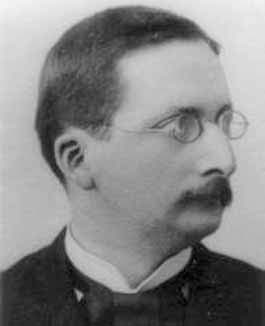


 تاريخ الرياضيات
تاريخ الرياضيات
 الرياضيات في الحضارات المختلفة
الرياضيات في الحضارات المختلفة 
 الرياضيات المتقطعة
الرياضيات المتقطعة
 الجبر
الجبر
 الهندسة
الهندسة 
 المعادلات التفاضلية و التكاملية
المعادلات التفاضلية و التكاملية 
 التحليل
التحليل
 علماء الرياضيات
علماء الرياضيات |
Read More
Date: 27-3-2017
Date: 25-3-2017
Date: 25-3-2017
|
Died: 24 January 1930 in Breslau, Germany (now Wrocław, Poland)

Adolf Kneser's father was a minister in the Protestant Church but, sadly, Adolf never knew his father who died when he was about one year old. One of his godparents was the physicist, and well-known scientific historian, Johann Christian Poggendorff. Adolf was one of his parents four sons and his mother, after the death of her husband, moved from Grüssow to Rostock where the boys could be educated. Adolf's secondary schooling took place in Rostock, and after this was complete he entered the University there. His remarkable talents are easily illustrated for even at this very early stage in his education, Kneser published his first paper which was on the refraction of sound waves. In order to get the best mathematical education available, he then moved to Berlin to study in the world leasing school of mathematics there.
He was taught at the University of Berlin by Kronecker and also influenced by Weierstrass. As was common among students at German universities at this time, he chose to study at different universities and as well as Rostock and Berlin, he also studied at Heidelberg. Kronecker and Kummer supervised his doctoral studies which ended in 1884 with the award of the degree from Berlin for his thesis Irreduktibilität und Monodromiegruppe algebraischer Gleichungen. After writing this thesis on algebraic functions and equations, he then worked on space curves. We should remark, however, that Kneser's interests were surprisingly broad and during his university studies he attended lectures on history, literature and philosophy. In fact as part of his doctorate he wrote a minor thesis on a philosophical problem, namely the relationship between the general laws of nature and the actual realities of nature.
Kneser submitted his habilitation thesis to the University of Marburg where he taught for a while, then he moved to Breslau (now Wroclaw in Poland) where he also lectured. In 1889 was appointed as an associate professor in Dorpat, Russia (now Tartu, Estonia) being appointed to the chair of Applied Mathematics there in the following year. It was while he held this chair that Kneser married Laura Booth in 1894. The couple had four sons; Hellmuth Kneser was born while they lived in Dorpat. A grandson of Adolf, and son of Hellmuth, was Martin Kneser who became a professor of mathematics holding a chair at Göttingen. In 1900 Adolf Kneser was appointed to the chair of mathematics at the Bergakademie (Academy of Mining) in Berlin. After five years in Berlin, he returned to Breslau where he spent the rest of his career.
Adolf Kneser's early work was on algebraic functions and equations. For example he published Zur Theorie der algebraischen Functionen (1887). From around 1888 he began his analytic investigations with the paper Elementarer Beweis für die Darstellbarkeit der elliptischen Functionen als Quotienten beständig convergenter Potenzreihen. He also studied space curves during the years 1888-1894, publishing papers such as Allgemeine Sätze über die scheinbaren Singularitäten beliebiger Raumcurven (1889). He is remembered, however, for work mainly in two areas. One of these areas is that of linear differential equations; in particular he worked on the Sturm-Liouville problem and integral equations in general. He wrote an important text on integral equations. The second main area of his work was the calculus of variations. He published Lehrbruch der Variationsrechnung (Textbook of the calculus of variations) (1900) and he gave the topic many of the terms in common use today including 'extremal' for a resolution curve, 'field' for a family of extremals, 'transversal' and 'strong' and 'weak' extremals [1]:-
His engagement in this classical topic was not the direct result of his studies with the field's great master, Weierstrass, but, rather, of his teaching experience at Dorpat. Kneser brought the theory of the so-called second variation to a certain conclusion. Especially, he favoured one of its geometric aspects, the theory of families of resolution curves and their envelopes, closely connected with the Jacobian theory of conjugate points. But above all, the decisive advances towards the solution of the so-called Mayer Problem, recently introduced to the calculus of variations, are due to Kneser.
In 1911 Kneser published his famous text, Die Integralgleichungen und ihre Anwendungen in der mathematischen Physik: Vorlesungen an der Universität zu Breslau. Wielandt, writing in his obituary of Hellmuth Kneser, describes Adolf Kneser as:-
... the first to introduce Hilbert's new methods into analysis in his textbook on integral equations. He devoted himself to the task of putting general results into concrete form by applying them to the functions of mathematical physics. In a sense, he made the boundary between the old and new mathematics his field of work.
Kneser's work, however, was surprisingly broad and he continued to show an interest in philosophy and knowledge theory which he had from his student days. Another two texts he published were Hobbes Und Die Staatsphilosophie (1924), and Das Prinzip der kleinsten Wirkung von Leibniz bis zur Gegenwart (The principle of the smallest effect from Leibniz to the present) (1928).
Books:
Articles:



|
|
|
|
تفوقت في الاختبار على الجميع.. فاكهة "خارقة" في عالم التغذية
|
|
|
|
|
|
|
أمين عام أوبك: النفط الخام والغاز الطبيعي "هبة من الله"
|
|
|
|
|
|
|
قسم شؤون المعارف ينظم دورة عن آليات عمل الفهارس الفنية للموسوعات والكتب لملاكاته
|
|
|